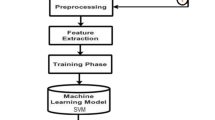Abstract
The proliferation of spam in Twitter poses serious social problems which affects society by causing people to commit crimes. For a better spam detection model, the challenge is to select optimal lightweight features that should be feasible to process a large number of tweets in very less time. This chapter focuses on discovering the optimal features from the dataset, developing various machine learning models for detection of spam and finally checking the stability of machine learning algorithms for varying sizes of training data. The dataset consists of user account and tweet based features from which the prominent features are selected using ensemble feature selection by employing different feature selection algorithms. Further, the effect of prominent features for spam detection is investigated using various machine learning algorithms. Comparative analysis of spam detection models is performed with the objective of finding the ones with the best performance and stability on large data sets of Twitter. The experimental results show that random forest classifiers perform better with an accuracy of 86.95%
Access this chapter
Tax calculation will be finalised at checkout
Purchases are for personal use only
Similar content being viewed by others
References
Li J, Liu H (2017) Challenges of feature selection for big data analytics. IEEE Intell Syst 32(2):9–15
Jin C, Ma T, Hou R, Tang M, Tian Y, Al-Dhelaan A, Al-Rodhaan M (2015) Chi-square statistics feature selection based on term frequency and distribution for text categorization. IETE J Res 61(4):351–362
Ebenuwa SH, Sharif MS, Alazab M, Al-Nemrat A (2019) Variance ranking attributes selection techniques for binary classification problem in imbalance data. IEEE Access 7:24649–24666
Hall MA (2000) Correlation-based feature selection of discrete and numeric class machine learning
Song J, Lee S, Kim J (2011) Spam filtering in twitter using sender receiver relationship. In: International workshop on recent advances in intrusion detection. Springer, pp 301–307
Ma J, Saul LK, Savage S, Voelker GM (2009) Identifying suspicious URLs: an application of large scale online learning. In: Proceedings of international conference on machine learning
Chen C, Zhang J, Chen X, Xiang Y, Zhou W (2015) 6 million spam tweets: a large ground truth for timely Twitter spam detection. In: 2015 IEEE International conference on communications (ICC). IEEE, pp 7065–7070
Wald R, Khoshgoftaar TM, Napolitano A (2013) Should the same learners be used both within wrapper feature selection and for building classification models? In: 2013 IEEE 25th International conference on tools with artificial intelligence. IEEE, pp 439–445
Reddy KS, Reddy ES (2019) Using reduced set of features to detect spam in twitter data with decision tree and KNN classifier algorithms. Int J Innovative Technol Exploring Eng (IJITEE):8(9):6–12
Morchid M, Dufour R, Bousquet PM, Linares G, Torres-Moreno JM (2014) Feature selection using principal component analysis for massive retweet detection. Pattern Recogn Lett 49:33–39
Mishra P (2019) Correlated feature selection for tweet spam classification. arXiv preprint arXiv:1911.05495v4
Herzallah W, Faris H, Adwan O (2018) Feature engineering for detecting spammers on twitter: modelling and analysis. J Inf Sci 44(2):230–247
Khalil H, Khan MUS, Ali M (2020) Feature selection for unsupervised bot detection. In: 2020 3rd International conference on computing, mathematics and engineering technologies (iCoMET). IEEE, pp 1–7
Imam NH, Vassilakis VG (2019) A survey of attacks against twitter spam detectors in an adversarial environment. Robot 8(3):50
Washha M, Qaroush A, Sedes F (2016) Leveraging time for spammers detection on twitter. In: Proceedings of the 8th international conference on management of digital ecosystems, pp 109–116
Author information
Authors and Affiliations
Corresponding author
Editor information
Editors and Affiliations
Rights and permissions
Copyright information
© 2023 The Author(s), under exclusive license to Springer Nature Singapore Pte Ltd.
About this paper
Cite this paper
Devi, K.K., Kumar, G.A.S., Shobana, B.T. (2023). Ensemble Learning Based Feature Selection for Detection of Spam in the Twitter Network. In: Yadav, R.P., Nanda, S.J., Rana, P.S., Lim, MH. (eds) Proceedings of the International Conference on Paradigms of Computing, Communication and Data Sciences. Algorithms for Intelligent Systems. Springer, Singapore. https://doi.org/10.1007/978-981-19-8742-7_50
Download citation
DOI: https://doi.org/10.1007/978-981-19-8742-7_50
Published:
Publisher Name: Springer, Singapore
Print ISBN: 978-981-19-8741-0
Online ISBN: 978-981-19-8742-7
eBook Packages: Intelligent Technologies and RoboticsIntelligent Technologies and Robotics (R0)




